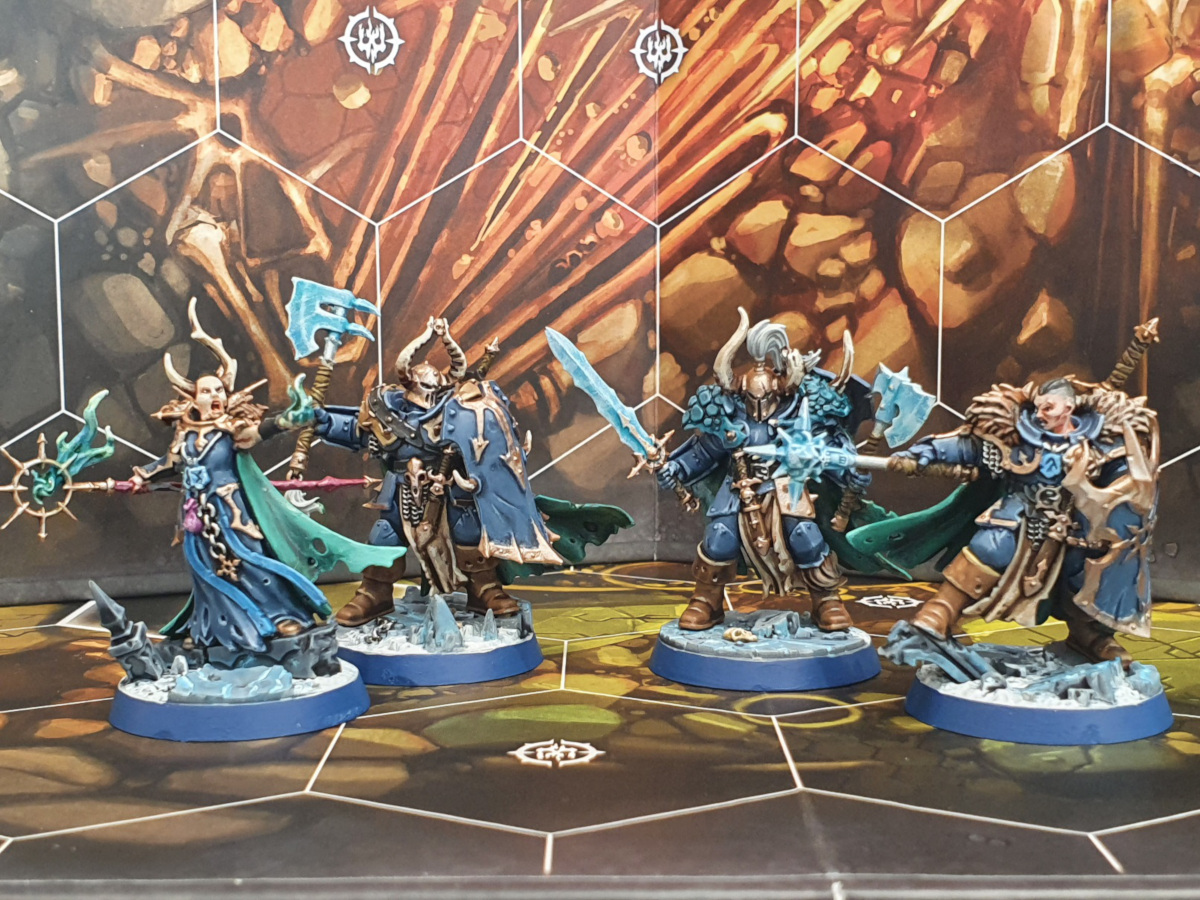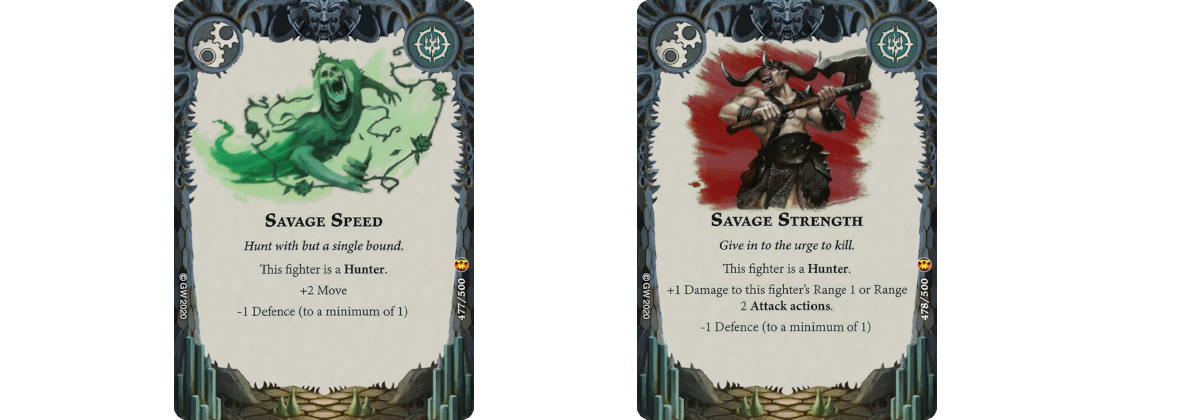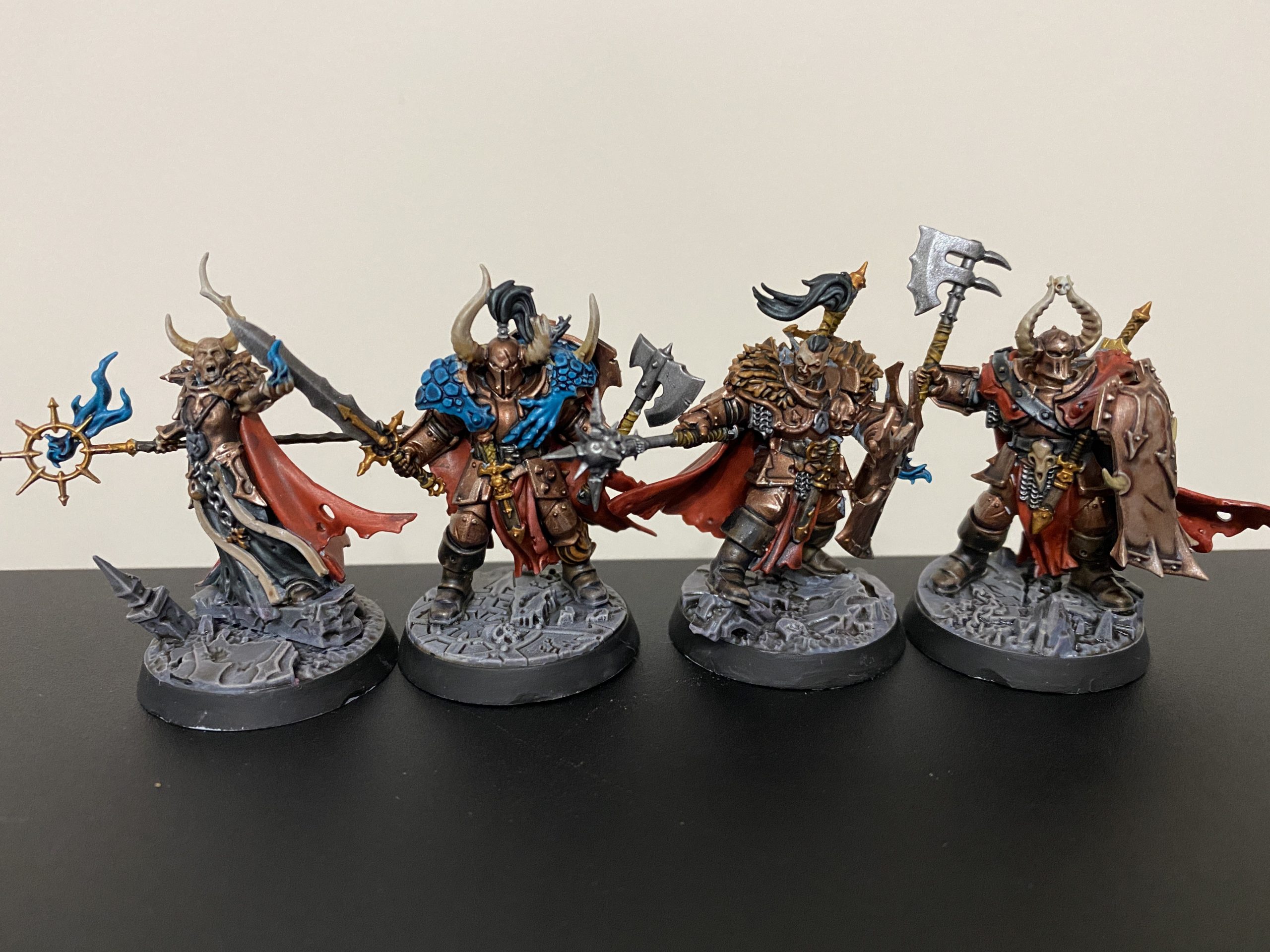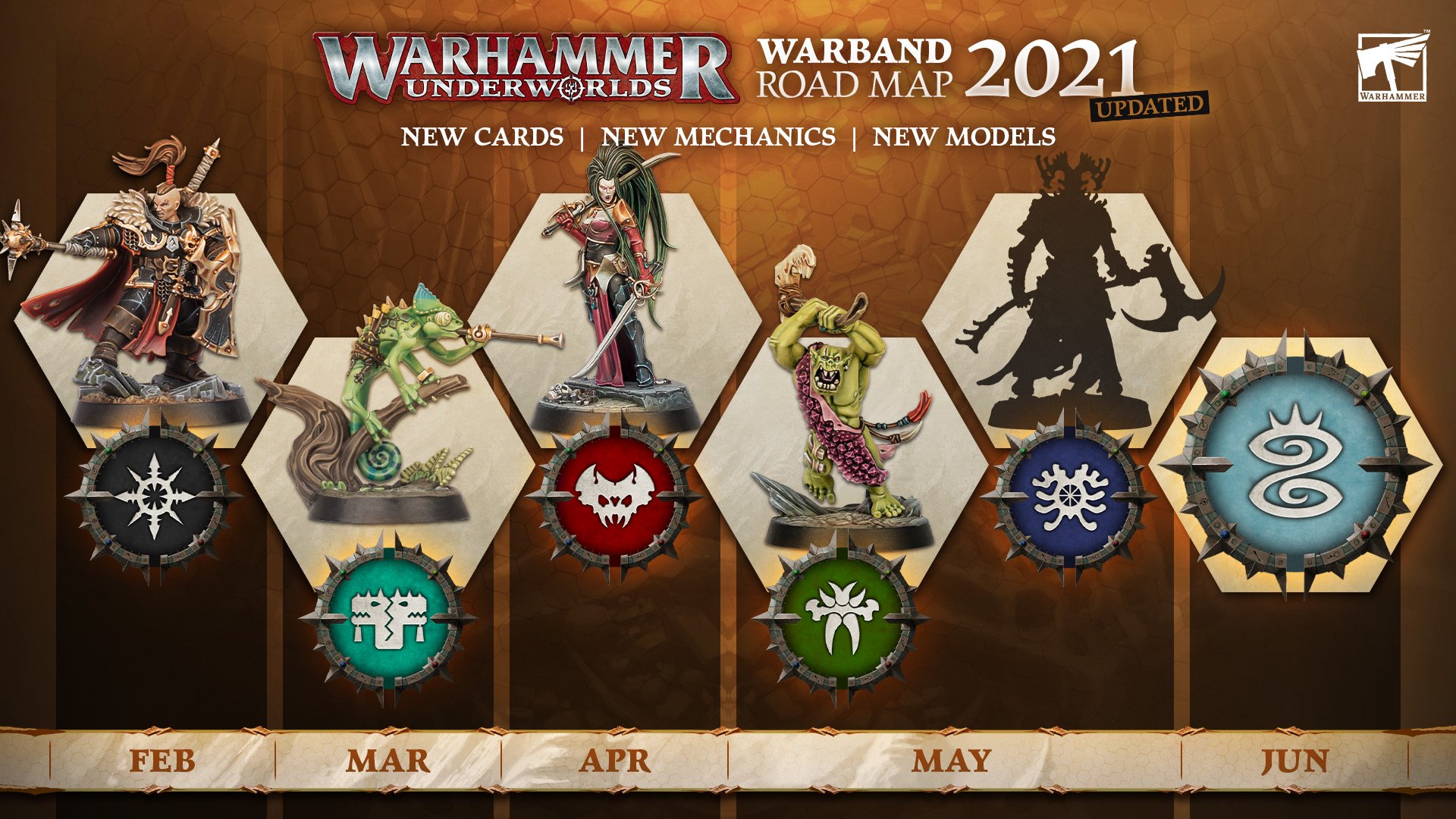Welcome to the first of a new GeekDad series about Games Workshop’s Warhammer Underworlds. The idea of the series is to examine the evolution of the game as each new warband comes out. The new “Vanguard” format was announced this season (which I waxed lyrical about in my review) Vanguard is rapidly becoming my favorite way to play the game, and so I thought I’d start a regular column Warhammer Underworlds “Vanguard Watch.” (Featured image is the Khagra’s Ravagers warband painted by The Reverend Maynard.)
One aspect of Underworlds that I always keep an eye on is what is it like to play for a busy parent? I love the game’s accessibility, but its ease of pick-up can sometimes be at odds with its billing as the “Ultimate Competitive Game.” If you want to compete with the best you sort of have to own ALL the cards (well, the current two seasons worth – Underworlds does have some card rotation). But for many of us, the ability to keep up with both the cost and the ever-shifting array of cards can be problematic. You might miss a season, and then be looking at a hefty catch-up price. (It should be recognized that collectible card/miniatures games are definitely not a cheap hobby. I think a full season of Underworlds is reasonably priced as tabletop gaming buy-ins go, but shelling out for a whole season at once can still put a $300 dent in your wallet.)
Enter Vanguard format. Vanguard format enables you just to play with a single (the most recent) season of cards.
I should probably mention at this point that for casual play ANY cards from any season are valid, but generally, if you go to a club or a store people will be anticipating that you’ll be playing to Championship rules. But, maybe, as meeting in person become more feasible, the Vanguard variant will become more prevalent. It should do as it’s a great way to play.

The Problem of Card Dominance.
Card games like Warhammer Underworlds have a peculiar phenomenon which can make them feel stale, that also, counter-intuitively, keeps them interesting too! And that is the “meta.” I’d never heard the term before playing Underworlds, and it’s a subject many hours of print could be devoted to. At its heart, meta means the optimum way to play.
There are many facets to being great at Warhammer Underworlds; it requires more than just a good deck of cards. There are positioning and in-game decision-making to be considered too, not to mention a slice of luck. No matter how good you are at those things, however, if your deck isn’t honed to a razor-sharp point, at the big competitions, you’re going to come up short. Good decks are as reliable and efficient as possible. At any one time in the game, there are probably only a handful of optimum builds. i.e. the meta. This means when you look around at games, out of the many hundreds of cards that can be employed, only a fraction of them are being used. (If stats like this float your boat, you can check them all out on the excellent Path to Glory and Well of Power websites.)
Due to the way Underworlds has evolved, it has tended to be the case that the earlier the season the stronger the cards. There are also, at any one time, more cards from the previous full season than the current part season, so it will inevitably feel like these cards are more prevalent. To deepen the problem, until season 4, the game’s core set has (largely) the same universal cards printed in them, meaning they have always been eligible for play. Some of these cards like Great Strength and Great Fortitude are incredibly powerful and have been seen in deck after deck for three years.
Vanguard changes all that.
Vanguard rules only allow cards from the Direchasm season. This means that lots of old favorites from last season and older core sets have been removed from the equation.

When Is Vanguard not Vanguard?
I’ve been playing in an online Tabletop Simulator tournament, and we have been playing with what might be termed “Vanguard+” rules (or edited Vanguard, as termed here, by one of the games’ “Grand Clash” winners, Matt from Set the Tempo.) In pure Vanguard, only warbands from the current season can be played, as this currently stands at only 3 warbands and there are 24 of us playing, we relaxed the ruling to allow any warband from any season can be used but players can only draw on only universal cards from Direchasm. This is not without its foibles, but for a semi-serious tournament where the main emphasis was having fun, the format has worked brilliantly.
Vanguard Iteration One – Key Points.
It’s early days yet in the Vanguard meta. At the time of writing, there are only universal cards available from the core set and one warband pack, Khagra’s Ravagers. This equates to only 62 universal cards to pick from. Decks in Underworlds usually contain 32 cards, so whilst each faction will have 32 of their own specific cards to draw on, we’re still going to find many decks carrying the same cards, especially when you consider that out of any pool of universal cards, a significant minority of them are going to be hot garbage. (It’s a curious truth of collectible card games, that many of the cards are rubbish and will always be rubbish, rarely seeing the light of day in competition). At this stage of things, there will be repetition across all decks for all warbands.
What Cards Keep Appearing in Vanguard?
Thanks to the game’s new Primacy mechanic, an aggressive playstyle is king right now. The primacy token is won by taking down enemy fighters. On its own gives a small end-of-turn boost to your glory total. Direchasm has already seen the introduction of cards that work off the primacy token, meaning that whilst keeping the token gives you a boost, the act of winning it, can deliver all important mid-turn glory. With such a restricted card pool, primacy objectives are hugely prevelant.
In the main Championship meta, backed up by all sorts of other heavily aggressive cards from the Arena Mortis pack, there’s not much room for subtlety; smashing things up works right now. The pared-down Vanguard meta allows for some more subtle interplay.
There is a trio of cards that add an extra facet to Primacy play. Feign Weakness, Feign Strength, and Underdog, enable you to play with the Primacy mechanic, even if you’re not all about killing your opposition’s fighters. Indeed, I’ve been running quite a successful, Grahrak’s Despoilers deck, which admittedly does pack a punch when you need it to, but also plays somewhat on the knowledge my weaker fighters are going to do a whole lot of dying.
There are also two cards in the set that are like old stalwarts, Great Strength and Great Speed, but they now come with a cost. Direchasm and Vanguard suggest that in Warhammer Underworlds the time of free lunches is over. 
What’s Missing?
At the moment, there’s not a great deal of joy to be had with the hold objective playstyle. Many strong hold objective cards have rotated out and with the loss of core set staple, Supremacy, a reliable Vanguard hold-objective strategy isn’t there yet. There are a couple of options in Treasure Hunter and Absolute Dominance but they require putting yourself in harm’s way or being reasonably confident your opponent isn’t going to be trying to do the same. In this meta, it’s harder to shift fighters from objectives once they’re sitting on them.
Which leads me to the second absence. Push cards. In the Championship meta for a very long time now, especially with the arrival of many fast-moving Beastgrave warbands, there has been almost nowhere to hide on the board. This is particularly true as there are so many push cards available. Whether you’re pushing enemy fighters to where you want them to be, or your own to help further your plans, the full game has a plethora of ways to manipulate the board state.
Not so in Vanguard. Unless you have your own in-faction push cards (and there are a good number of those about), so far, the Direchasm universals aren’t offering much. There is also currently no way in which to move objectives, so if you are playing a limited objective game, you have to work to get on them, but if you do, at least you know nobody will whip them out from under your feet.
In the Vanguard format where you position your fighters matters. This is not to say it doesn’t in the full game, but if you do make a positioning mistake it is often possible to correct it or compensate for it. (I’m sure the top players would disagree with this observation, after all, correcting a mistake takes resources that could have been used to press an advantage.) Vanguard also makes it easier to set up in a way that protects precious fighters. When playing with a full Championship complement, there are few places on the board to hide.
Finally, there are currently no card draw cards. In a game where deck efficiency is key, being able to draw extra cards is invaluable. At the moment, there’s no way to accelerate the process of finding those key cards.
What Does This Mean for the Game?
Well, I haven’t played an exhaustive sample of games, but I have been playing in a league with 23 other players and the consensus seems to be that the Vanguard format is fun, and adds an array of tactical challenges not present in the main game. Personally, I prefer it, but I think that may just be my aging brain and busy schedule mean I don’t have time to wade through hundreds of cards looking for optimum combinations; nor do I particularly enjoy doing so.
I think true Vanguard is a great way to play the game if you’re new to it, and I hope to see some tournaments using the format once such things become possible again. I also think it’s a great way to dive back into Warhammer Underworlds, if you’ve fallen behind. Playing competitive catch-up is a real-problem, and Vanguard is a handy firebreak to help you out. Vanguard+ is an awful lot of fun too. I’ve very much enjoyed the tactical cut and thrust of the games I’ve played. And don’t just take my word for it, check out the words of Grand Clash winner, Matt, from Set the Tempo.

Where next?
We’re promised another new warband during March, the Starblood Stalkers, the first Lizardmen warband in the game. Their inspire condition requires that they sit on objectives, so I imagine we’ll see some cards that boost that style of play. One card that has been spoiled that will come with this warband is one that flips objective tokens. I’m interested to see how that mechanic works out in the Vanguard meta; at the moment there’s not much need to do it.
Further ahead, we have the arrival of some entirely cool-looking vampires (that will also tie in with the new Warhammer Quest: Cursed City release) and some Savage Orcs. These warbands will expand on the new Hunger and Primacy mechanics. The Hunger mechanic doesn’t have enough…err…bite to sate any appetites just yet, so it will be interesting to see if we’re going to be able to build decks around it as more cards become available. Primacy is very much here, and I hope the forthcoming cards maintain game balance.
So there is it, an introduction to the Vanguard meta. I hope it was useful. This column is a rather specialized post compared with much of GeekDad’s content, but hopefully, if you’ve read this far, I can tempt you to play the game. If you’ve discovered GeekDad from coming over from Warhammer Underworlds, stick around, there’s lots of great gaming and geek culture content here for you to enjoy. I’ll be back after the Starblood Stalkers have hit the shelves to look at how they’ve shaken up the Vanguard meta.







